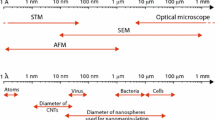Abstract
The use of atomic force microscope (AFM) as a nanomanipulator has been evolving for various kinds of nano-manipulation tasks. Due to the bow effect of the piezo scanner of the AFM, the AFM space is different from the Cartesian space. Traditional nanomanipulation based on AFM is only a 2-D operation and does not consider the bow effect of the piezotube. In this paper, different 3-D nanomanipulation tasks using AFM such as nanolithography, pushing and cutting have been discussed. 3-D path planning is performed directly in the AFM space and the 3-D paths are generated based on the 3-D topography information of the surface represented in the AFM space. This approach can avoid the mappings between the AFM space and Cartesian space in planning. By following the generated motion paths, the tip can either follow the topography of the surface or move across the surface by avoiding collision with bumps. Nanomanipulation using this method can be considered as the “true” 3-D operations since the cantilever tip can be controlled to follow any desired 3-D trajectory within the range of AFM space. The experimental study shows the effectiveness of the planning and control scheme.
Similar content being viewed by others
References
Kim Y, Lieber CM. Machining oxide thin films with an atomic force microscope: pattern and objective formation on the nanometer scale.Science, 1992, 257(5068):375–377
Luthi R, Meyer E, Haefke H, et al. Sled-type motion on the nanometer scale: Determination of dissipation and cohesive energies of C60.Science, 1994, 266(5193):1979–1981
Schaefer DM, Reifenberger R, Patil A, et al. Fabrication of two-dimensional arrays of nanometer-size clusters with the atomic force microscope.Applied Physics Letters, 1995, 66:1012–1014
Junno T, Deppert K, Montelius L, et al. Controlled manipulation of nanoparticles with an atomic force microscope.Applied Physics Letters, 1995, 66(26):3627–3629
Requicha AAG, Baur C, Bugacov A, et al. Nanorobotic assembly of two-dimensional structures. In: Proc IEEE Int. Conf. Robotics and Automation, Leuven, Belgium, May 1998, 3368–3374
Hansen LT, Kuhle A, Sorensen AH, et al. A technique for positioning nanoparticles using an atomic force microscope.Nanotechnology, 1998, 9:337–342
Yu MF, Dyer MJ, Skidmore GD, et al. Three-dimensional manipulation of carbon nanotubes under a scanning electron microscope.Nanotechnology, 1999, 10:244–252
Dong L, Arai F, Fukuda T. 3d nanorobotic manipulations of multi-walled carbon nanotubes. In: Proc IEEE Int Conf Robotics and Automation, Seoul, Korea, May 2001. 632–637
Dong L, Arai F, Fukuda T. 3d nanoassembly carbon nanotubes through nanorobotic manipulation. In: Proc IEEE Int Conf Robotics and Automation, Washington DC, USA, May 2002. 1477–1482
Guthold M, Falvo MR, Matthews WG, et al. Controlled manipulation of molecular samples with the nanomanipulator.IEEE/ASME Transactions on Mechatronics, 2000, 5(2):189–198
Sitti M, Hashimoto H. Tele-nanorobotics using atomic force microscope. In: Proc IEEE Int Conf Intelligent Robots and Systems, Victoria, BC, Canada, October 1998. 1739–1746
Stark RW, Thalhammer S, Wienberg J, et al. The AFM as a tool for chromosomal dissection—the influence of physical parameter.Applied Physics A, 1998, 66:579–584
Dedkov GV. Experimental and theoretical aspects of the modern nanotribology.Physical Status of Solid (a), 2000, 179:3–75
Falvo MR, Superfine R. Mechanics and friction at the nanometer scale.Journal of Nanoparticles Research, 2000, 2:237–248
Falvo MR, Taylor RM, Helser A, et al. Nanometerscale rolling and sliding of carbon nanotubes.Nature, 1999, 397:236–238
Akila J, Wadhawa SS. Correction for nonlinear behavior of piezoelectric tube scanners used in scanning tunneling and atomic force microscopy.Review of Scientific Instruments, 1995, 66:2517–2519
Barrett RC, Quate CF. Optical scan-correction system applied to atomic force microscope.Review of Scientific Instruments, 1991, 62:1393–1399
Croft D, Shed G, Devasia S. Creep, hysteresis, and vibration compensation for piezoactuators: atomic force microscopy application.ASME Transactions on Journal of Dynamic Systems, Measurement, and Control, 2001, 123:35–43
Author information
Authors and Affiliations
Additional information
The project supported by the National Natural Science Foundation (IIS-9796300, IIS-9796287 and EIA-9911077)
Rights and permissions
About this article
Cite this article
Guangyong, L., Ning, X., Yuechao, W. et al. Planning and control of 3-D nano-manipulation. Acta Mech Sin 20, 117–124 (2004). https://doi.org/10.1007/BF02484254
Received:
Issue Date:
DOI: https://doi.org/10.1007/BF02484254




